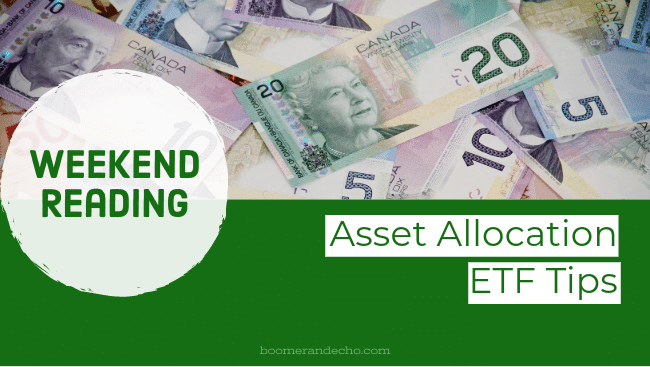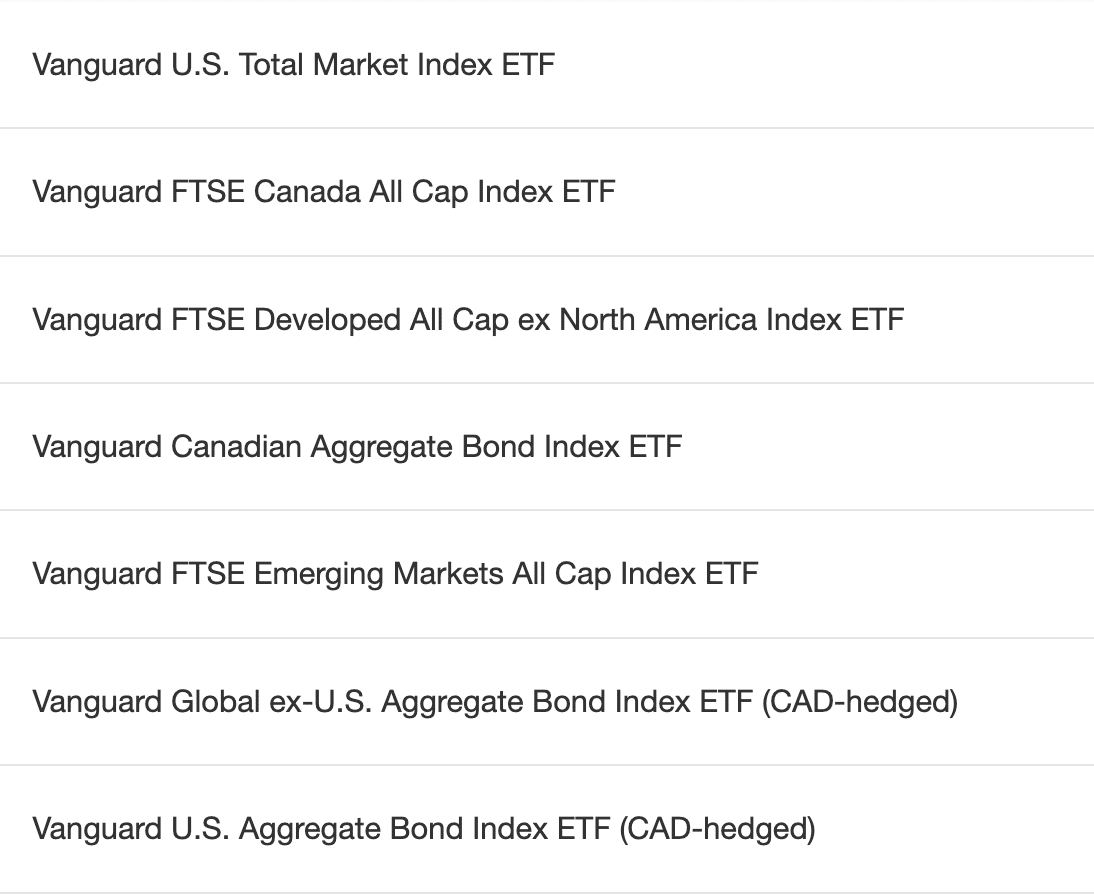Weekend Reading: Asset Allocation ETF Tips

Asset allocation ETFs revolutionized investing for do-it-yourself investors when they were first introduced by Vanguard in 2018.
Prior to the existence of these multi-asset ETFs, passive investors might have opted to follow one of the Canadian Couch Potato’s model portfolios to build their own multi-ETF portfolio (remember the 10-ETF Über-Tuber portfolio?).
That’s why I say asset allocation ETFs have been such a game changer for self-directed indexers. I take it a step further and say investing complexity has largely been solved with these all-in-one funds.
Many investors agree, as Vanguard’s Growth ETF (VGRO) has taken in $4.84B in assets in six years, while Vanguard’s All Equity ETF (VEQT) has gathered $3.69B in assets in five years of existence. I invest my own money in a single asset allocation ETF in each of my account types.
Despite their growing popularity, myths and misconceptions about asset allocation ETFs frustratingly still persist today.
Just one fund?
The most common push back against moving to an asset allocation ETF is that investors think they’re putting all of their eggs in one basket. But this is just an illusion. Asset allocation ETFs are simply a fund-of-funds that contain 4-8 underlying ETFs.
Like the old Couch Potato model portfolios, these individual ETFs have just been neatly packaged up into a single, automatically rebalancing product.

It’s also a pretty darn big basket. For instance, VGRO contains more than 13,500 global stocks and 19,000 global bonds.
Finally, holding a single globally diversified ETF is no different than how many Canadians currently invest at their bank branch. Consider most cookie-cutter bank portfolios (like the RBC Select Growth portfolio (RBF459) are also invested in just a single globally diversified mutual fund.
The big differentiator is that VGRO comes with a total MER of just 0.24% while the RBC Select Growth portfolio charges an almost criminal 2.04% MER (but at least you get a phone call once a year at RRSP season – maybe).
Really, just one?
Okay, so you’ve been convinced that holding an asset allocation ETF is a good idea, but which one?
Vanguard, iShares, BMO, Horizons, TD, Mackenzie, and Fidelity all offer a suite of asset allocation ETFs. And, the suites contain everything from 100% global equities to a conservative 20% equity / 80% bond mix. Shouldn’t you hold a few to spread your risk around?
Umm, no. These products are truly designed to be a one-ticket solution for your portfolio. Pick one that best represents your risk tolerance and time horizon and move on with your life.
Need help deciding? Watch this:
Here are two scenarios in which I’ll concede that holding multiple asset allocation ETFs makes good sense:
- Hedging your bets: Can’t decide between VGRO and XGRO? Hold one in your RRSP and the other in your TFSA (assuming you have the same risk profile in both account types). Or, as a couple, one spouse picks the Vanguard fund and the other spouse picks the iShares fund.
- Odds or evens?: Asset allocation ETFs are typically offered in increments of 20%. Meaning, if you are an oddball with a target mix of 90/10, 70/30, or 50/50 you’ll be hard pressed to find a one-fund solution. In this case, split your portfolio evenly between a 100/0 and 80/20 fund to create your desired 90/10 mix. Or hold the 80/20 fund and 60/40 fund to create your 70/30 allocation.
Double-dipping on fees?
Asset allocation ETFs bundle 4-8 individual ETFs into one easy to manage solution and typically charge a fee of between 0.20% to 0.25%. But one common concern for individual investors is whether they’d also be charged the MER on each of the underlying ETFs – essentially double-dipping on the fees.
Let’s put that myth to rest right now. What you see is all there is when it comes to the MER associated with an asset allocation ETF. There are no hidden fees or double-dip charges for the underlying funds.
While you could technically hold the underlying funds yourself at a slightly cheaper cost, you could also pay a slightly higher convenience fee to have those ETFs bundled into one self-rebalancing product.
Ask yourself whether the juice is worth the squeeze when it comes to adding complexity to your portfolio just to save a few basis points of cost.
This Week’s Recap:
Revisit my last weekend reading where I asked where are my customers’ yachts?
From the archives: Here’s how early retirees can more accurately estimate their CPP benefits.
RIP to behavioural psychologist legend Daniel Kahneman, who passed away earlier this week at the age of 90:
I emailed Daniel Kahneman several years ago asking about peculiar behaviour I noticed amongst credit card users. To my surprise he kindly replied right away with his classic line of “What You See is All There Is.”
RIP to an absolute legend https://t.co/gPifESvuMY
— Boomer and Echo (@BoomerandEcho) March 27, 2024
Promo of the Week:
Have you noticed that credit card companies have started to communicate with you about when your annual fee is due? I’ve received notifications from American Express and from CIBC in recent weeks, which makes me wonder if this is something that has been regulated or mandated (anybody know?).
I’m all for it, since I often forget to call and cancel a card ahead of the annual fee being charged.
Speaking of credit cards, I’ll continue to beat the drum about the American Express Cobalt – the best card for everyday spending in Canada with 5x points for food & drink. Sign up and spend $750 per month on this card to get an extra 15,000 Membership Rewards points (plus the 45,000 points you’d earn if you spend $750 per month on a 5x spending category).
Then use your own referral link to refer your spouse or partner (called: activating Player 2), and have them do the same thing. This could be worth a total of 120,000 Membership Rewards points in a year, plus another 10,000 for the referral bonus.
Also, for business owners and side hustlers, the best sign-up bonus in Canada right now is for the American Express Business Gold Card, where you’ll get 75,000 Membership Rewards points when you spend $5,000 within the first 3 months. The annual fee is just $199, which is reasonable for a business card.
Weekend Reading:
How to cope with the RRSP-to-RRIF deadline in your early 70s.
Picking a financial advisor? There are red flags you should know about.
Preet Banerjee on why those most likely to benefit from a budget are least likely to have one.
Sometimes we do stupid shit, and everything works out. On most occasions, it doesn’t.
Ben Felix explains why it’s dangerous to assume that stocks will return 10-12% per year.
More on that assumption here:
Morningstar’s Christine Benz on how to declutter your investor portfolio.
Tales of charlatans and chagrin from the Loonie Doctor blog:
“Before you scoff and claim that it would never be you, know that these stories take in people from all walks of life. Less financially sophisticated people may not recognize the danger. Financially sophisticated people are juicy targets because they have money and are often looking for new ways to invest.”
A well-traveled crew of retirees share their savviest tips and tricks – from travel days to avoid, to must-pack items.
Investment advisor Markus Muhs shares how he invests his money and his own money story.
A cash wedge can make good sense for retired investors, at least from a psychological perspective. A Wealth of Common Sense blogger Ben Carlson looks at the 60/30/10 portfolio.
The wacky negative interest rate experiment never gained traction economically but went on for more than a decade anyway. What was gained? (sub may be required)
Mortgage expert Rob McLister explains why putting discretionary income towards a mortgage is often not the winning play.
Finally, a must-listen podcast on overcoming frugality in retirement and why it takes a bit of a leap of faith to learn to let go and spend your money.
Have a great weekend, everyone!


That was a great explanation of how to think about asset allocation ETFs! And thanks for sharing about the gift of interacting with Daniel Kahneman – I’m going to go find his book now, may he rest in peace!
Thanks for the travel article link. My spouse and I have been learning some of the travel do’s and don’ts the hard way the last few years and are still refining our best travel model. Lots of great tips that we will further action.
Many thanks, great article. We are in the market for an all in one ETF but would not want the Canadian exposure.Do they have any all in one ETF’s without the Canadian exposure? We have a large non-registered portfolio of Canadian dividend stocks and don’t need the Canadian exposure. Maybe just a mix of the rest of the underlying ETF’s might be the answer? The ETF’s would all be in RSP accounts.
Hi Pete, you can buy an All World, ex Canada ETF. Vanguard’s VXC or iShares’ XAW would do the trick.
Thx, either one looks good for us. We’ll get a couple of bond funds to go along with them and we’re set
Have a great weekend